Quick Summary:
Are you looking for developing a robust and scalable application using Python? And you’re not clear about which python frameworks or libraries to use in your project? Don’t worry you’re at the right place! After reading this blog, you will be able to make an informed decision about which libraries & python web frameworks to use along with what checklist to keep in mind while selecting the same.
With various frameworks and libraries, python allows developers to work in an technical domain. Take a peek at such python frameworks & libraries which can be used in year 2023.
Introduction
Python is often labelled as a versatile and beginner-friendly programming language. In addition to this, it comes with various prepacked libraries which can help developers by saving development time & effort. As pointed out earlier, python has a sea of libraries available. This is one of the biggest reasons why Python is popular among the developer community.
But as it is said there is another side of the story as well, as helpful as it is to have hundreds and thousands of libraries at your disposal, it can also become a tedious task to select the best Python framework & libraries as per your project requirements. In this blog, you will get insight into an overview of Python web framework & libraries, factors to keep in mind while selecting the web framework for python, and much more.
So, without further ado, Let’s dive in!
Stats related to Python
So before diving into the world of Python frameworks & libraries, look at the stats which will justify the popularity of Python.
According to Statista,
- Various Python libraries are included in the most used libraries and frameworks among developers, worldwide, as of 2022.
- With respect to deployment type, python has scored 3rd rank in programming languages used by software developers worldwide as of 2022
According to the Stack overflow developer survey 2022,
- In 2022, Python scored 43.51% for professional developers using Python, whereas for people learning to code, it scored a whopping 58.38%.
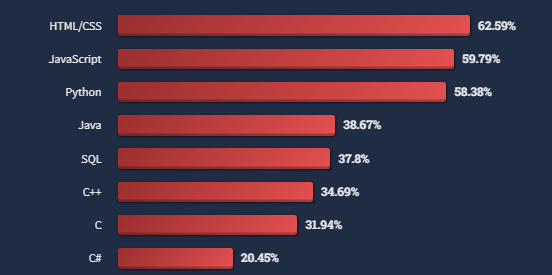
- In the section on other frameworks and libraries, there are Python libraries everywhere as well.
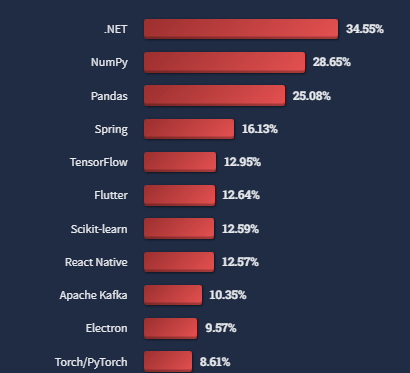
Best Python Frameworks & Libraries to Use in 2023
Python has a vast ecosystem of frameworks & libraries which greatly enhance the development process and empower developers to build robust and efficient applications.

From web development to scientific computing and machine learning, Python has a solution for nearly every domain making it the popular choice in the code learning community along with experienced professionals. The top Python web development frameworks & software libraries that we have utilized in projects for our clients are shown in the list below. Let’s take a look.
| Library/Framework | Source Rank | Dependencies | Latest Release | First Release |
| Django | 30 | 6 | May 3, 2023 | May 17, 2010 |
| Pyramid | 16 | 21 | Jan 30, 2023 | Nov 5, 2010 |
| Bottle | 11 | 0 | Jun 10, 2020 | Jun 10, 2020 |
| Tornado | 25 | 0 | Jul 3, 2022 | May 18, 2010 |
| Flask | 19 | 5 | Feb 15, 2023 | Sep 11, 2017 |
| aiohttp | 27 | 13 | Sep 21, 2022 | Oct 25, 2013 |
| Pre-commit | 26 | 5 | Jan 29, 2023 | Jun 17, 2014 |
| Request | 32 | 6 | Jan 12, 2023 | Feb 14, 2011 |
| NumPy | 22 | 6 | Feb 28, 2023 | Sep 11, 2017 |
| Pandas | 23 | 8 | Mar 3, 2023 | Sep 11, 2017 |
| Pillow | 29 | 17 | Jan 2, 2023 | Jul 31, 2010 |
| TensorFlow | 20 | 0 | Dec 29, 2022 | Jan 19, 2018 |
| Scikit-Learn | 29 | 23 | Jan 24, 2023 | Sep 22, 2011 |
| PyTorch | 20 | 5 | Feb 1, 2023 | Nov 22, 2017 |
| OpenCV | 19 | 22 | Feb 15, 2023 | Dec 5, 2017 |
Django
Stars: 70.4K |Forks: 29.2K |Contributors: 2,390
Type: Framework
Mainly used for: Fast & simplified website development
Install: pip install Django==4.2.1
License: BSD-3-Clause
You cannot start any python framework list without adding Django in it. Django is a high-level web framework that simplifies web application development. Django emphasizes on DRY (Don’t Repeat Yourself), and comes with ready-to-use features like a login system, database connection, and CRUD operations. It follows MVT (Model-View-Template) architecture. It also provides tools that manage database management, URL routing, template rendering, user authentication, and more. With a focus on reusability and maintainability, Django framework in python is popular for building robust and scalable web applications.
Key features
- Django provides an Object Relational Mapping (ORM) that simplifies database interaction by using Python Objects
- It follows MVT (Model View Template) architecture, promoting code organization and reusability
- It includes a robust URL routing system for mapping URLs to views
- Django’s template engine separates the presentation logic from the business logic
- Built-in form handling in Django provides features like form validation and error handling
- Django emphasizes security with built-in measures to protect against several web vulnerabilities
- Django supports Internationalization and Localization, allowing the development of global applications
- Django is designed to handle high-traffic loads efficiently, making it scalable and performant
Use Cases
- Web Application Development
- Content Management System
- E-commerce Platforms
- Social Networking Platforms
- Data Analytics and visualization
- APIs and Web Services
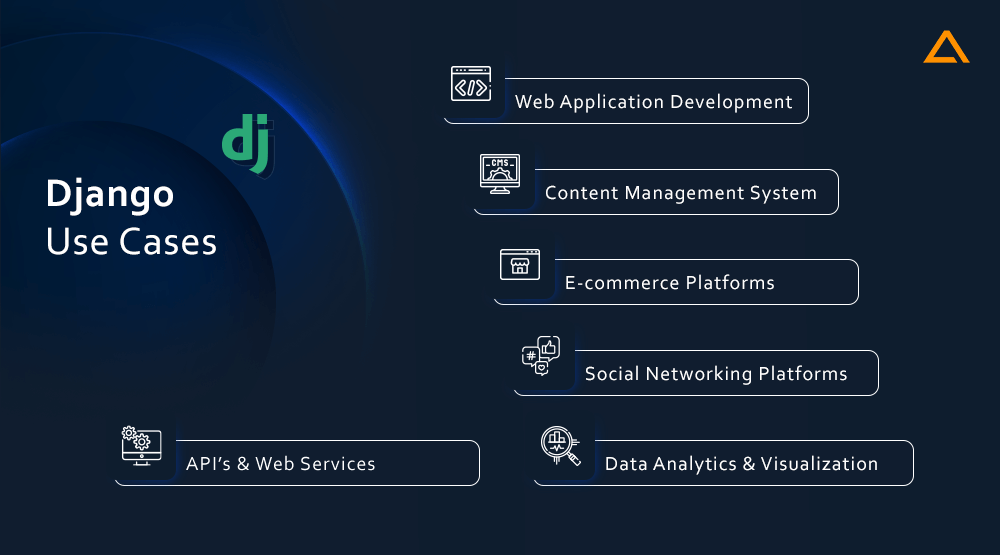
Pros and Cons
| Pros | Cons |
| Rapid development | Learning Curve |
| Scalability | Complexity for small projects |
| Security features | Lack of flexibility |
| Administration Interface | Performance overhead |
| Strong Community | ORM Limitations |
| Versatility | – |
Pyramid
Stars: 3.8K |Forks: 895 |Contributors: 278
Type: Framework
Mainly used for: Web development
Install: pip install pyramid==2.0.1
License: Zope Public License (ZPL)
Pyramid is a lightweight & flexible Python web framework that prioritizes simplicity and customization. With the minimalistic approach, it gives developers complete control over the application’s structure and components. Designed for scalability and performance along with various features including different URL patterns, supports multiple templating engines, and built-in features for authentication and authorization. In addition to all this, it also has comprehensive documentation and an active community making it a popular choice for developers who are looking for customizable python web dev frameworks.
Key features
- Pyramid emphasizes simplicity and minimalism, allowing developers to selectively add necessary components
- URL dispatching in Pyramid provides a powerful mechanism for handling diverse URL patterns and HTTP methods
- Pyramid supports multiple templating engines, enabling the separation of presentation and application logic
- Built-in features in Pyramid facilitate authentication and authorization for secure user access control
- Pyramid offers flexibility in configuration through Python code or files, catering to project-specific needs
- Testing and debugging are made efficient in Pyramid with robust utilities and a debugger
- Pyramid supports middleware, enabling integration of additional functionality and customization of request/response processing
- Pyramid is compatible with various deployment options, including servers, WSGI containers, and cloud platforms
- Pyramid benefits from an active community and comprehensive documentation, providing valuable support and resources
Use Cases
- Custom Web Applications
- Content Management System
- API and Web Services
- Single Page Applications
- Prototyping and Proof of Concepts
- Enterprise Applications
- Microservices
- Real-time Applications
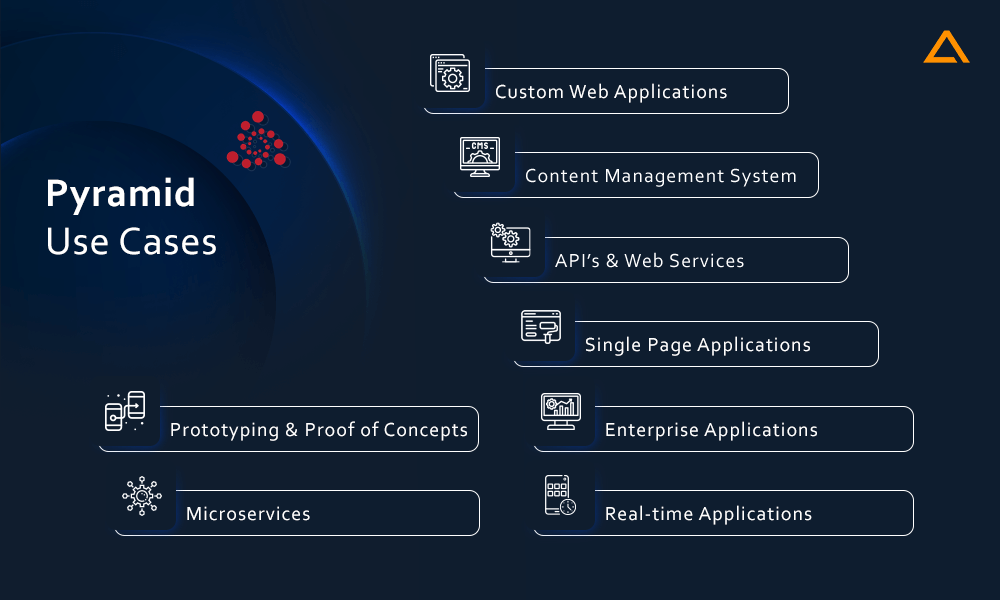
Pros and Cons
| Pros | Cons |
| Flexibility | Learning Curve |
| Minimalistic Approach | Initial Setup |
| Scalability | Manual component integration |
| Extensibility | Small Ecosystem |
| Debugging & Testing | – |
| Proper Documentation | – |
| Strong Community | – |
Note: Although the points are listed in cons they don’t need to be drawbacks for all projects which use a pyramid. They can be pros as well for certain projects. Ultimately, the suitability or usefulness of a pyramid boils down to your project requirements.
Also Read: – Python Optimization: Performance, Tips & Tricks
Bottle
Stars: 8K |Forks: 1.5K |Contributors: 190+
Type: Framework
Mainly used for: Developing small to medium-sized web applications, APIs, mock-up
Install: conda install -c conda-forge bottle
License: MIT
The bottle is a fast, simple, and lightweight WSGI micro web-framework for Python. With its minimalistic design and small codebase, it is easy to use. The bottle is distributed as a single file module, which helps it in integrating with the projects without much complexity. It is an ideal choice for small to medium-sized web applications and prototyping as it provides in-built support for routing, handling HTTP requests & response as well as working with templates.
Key Features
- Bottle’s lightweight & simple design offers a minimalistic approach to web development
- Built-in URL routing capabilities for easy request mapping
- Convenient handling of HTTP requests and responses
- Support for various templating engines
- Built-in user session management
- Simplified handling of client file uploads
- Easy processing and validation of form data
- Features for building RESTful APIs
- Plugin support for added functionality
- Easy integration with no complex setup or installation
Use Cases
- Small Projects
- Microservices and APIs
- Single-Page Applications
- Proof of concepts and Prototyping
- Web Services & Utilities
- Educational Projects
- Embedding in other projects
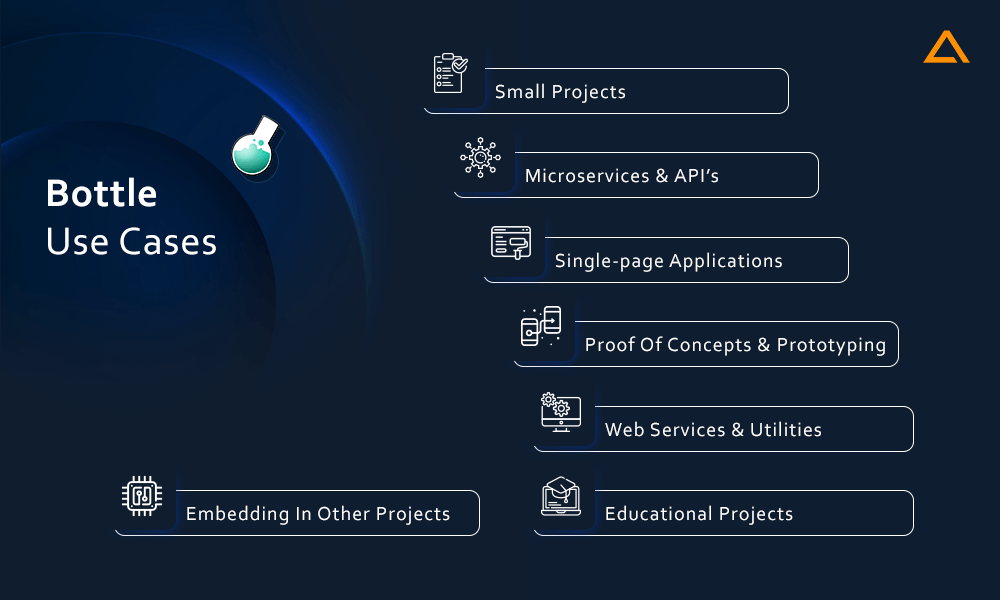
Pros and Cons
| Pros | Cons |
| Lightweight | Limited Scalability |
| Simplicity | Lack of Advanced Features |
| Fast Development | Smaller Community |
| Easy to Integrate | Smaller Ecosystem |
| RESTful Support | Limited Template Support |
Tornado
Stars: 21.1K |Forks: 5.5K |Contributors: 360+
Type: Framework
Mainly used for: Developing high-performance web applications and APIs.
Install: pip install tornado==6.2
License: Apache-2.0
Tornado is a high-performance Python web framework and asynchronous networking library. This best python framework for web development is known for its ability to handle thousands of simultaneous connections with low latency. Tornado is popular for building scalable, real-time web applications and APIs, thanks to its asynchronous I/O capabilities, request handlers, templating engine, and integration flexibility with existing applications. Apart from all this, it includes its web server, supports WebSockets, and employs an event-driven architecture for efficient handling of concurrent requests.
Key Features
- Asynchronous I/O for efficient handling of concurrent requests & non-blocking operations
- Built-in web server eliminating the need for additional servers like Nginx or Apache
- WebSocket’s support real-time bidirectional communication
- Request handler model for routing and handling different types of HTTP requests
- Templating engine for generating dynamic web pages
- Security features include secure cookies, input validation, and XSS protection
- Scalability with the ability to handle large numbers of concurrent connections
- Integration flexibility with existing applications or frameworks
- Active community & comprehensive documentation providing resources and support for developers
Use Cases
- Real-Time Application
- Web APIs
- Streaming Services
- Web Sockets Application
- Asynchronous Microservices
- Proxy Servers
- High Volume Websites
- IoT
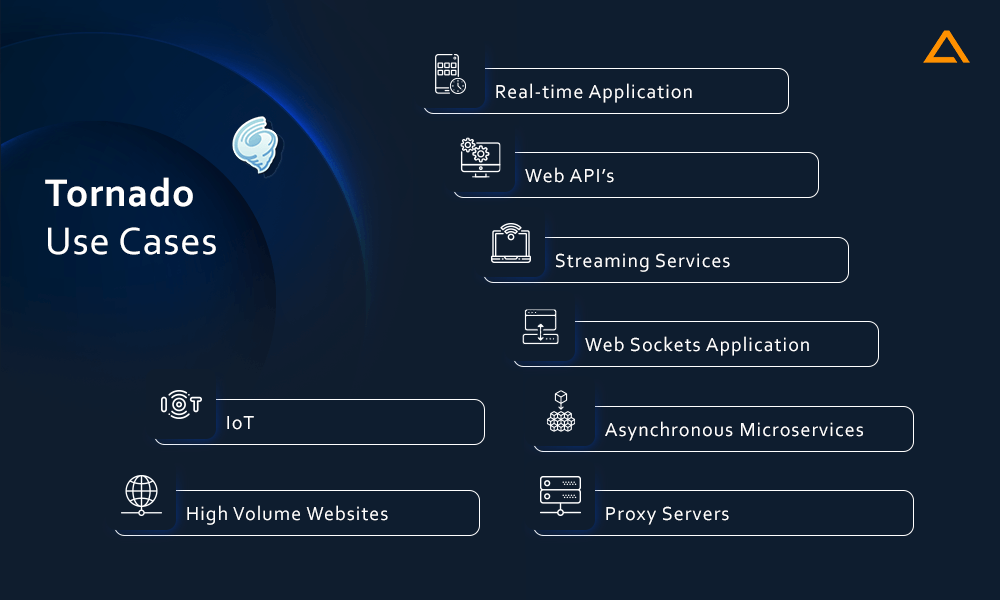
Pros and Cons
| Pros | Cons |
| High Performance | Steep Learning Curve |
| Scalability | Limited Eco-system |
| Real-Time Capabilities | Complexity for Simple Application |
| Lightweight | Lack of Built-in ORM |
| Python Integrations | – |
| Web Server Included | – |
| Community & Documentation | – |
Flask
Stars: 63K |Forks: 15.6K |Contributors: 700
Type: Framework
Mainly used for: Developing async applications & HTTP/RESTful APIs
Install: $ pip install -U Flask
License: BSD-3-Clause license
Flask is a lightweight and flexible Python web framework used for building web applications and APIs. It emphasizes simplicity and minimalism, providing the essential tools for web development. With a built-in routing system, a templating engine for dynamic content, and extensibility through various plugins, flask framework python enables developers to create small to medium-sized web applications, prototypes, and RESTful APIs efficiently. It is highly regarded for its simplicity, ease of use, and flexibility, making it one of the most popular python frameworks.
Key Features
- Flask is a lightweight framework that enables quick & efficient development of web development
- Flask provides a flexible and intuitive routing system for different types of HTTP requests
- The powerful templating engine in Flask allows for dynamic content generation & seamless integration with HTML templates
- Flask’s extensibility allows for easy integration of additional functionality through a wide range of plugins & extensions
- It is highly compatible & versatile making Flask a seamless integration with other Python libraries
- Python Flask web framework facilitates easy testing and debugging due to the in-built development server
- Flask-WTF extension simplifies integration with forms, form validation, and security features for user input handling
- Flask has a vibrant community and comprehensive documentation, providing valuable resources and support to developers
- Flask’s modular design enables scalability, allowing for easy expansion and management as projects grow
Use Cases
- Web applications
- RESTful APIs
- Prototypes and experimentation
- Microservices
- Single-Page Applications (SPAs)
- Internal tools and dashboards
- Educational projects
- IoT applications
- Custom solutions tailored to specific requirements
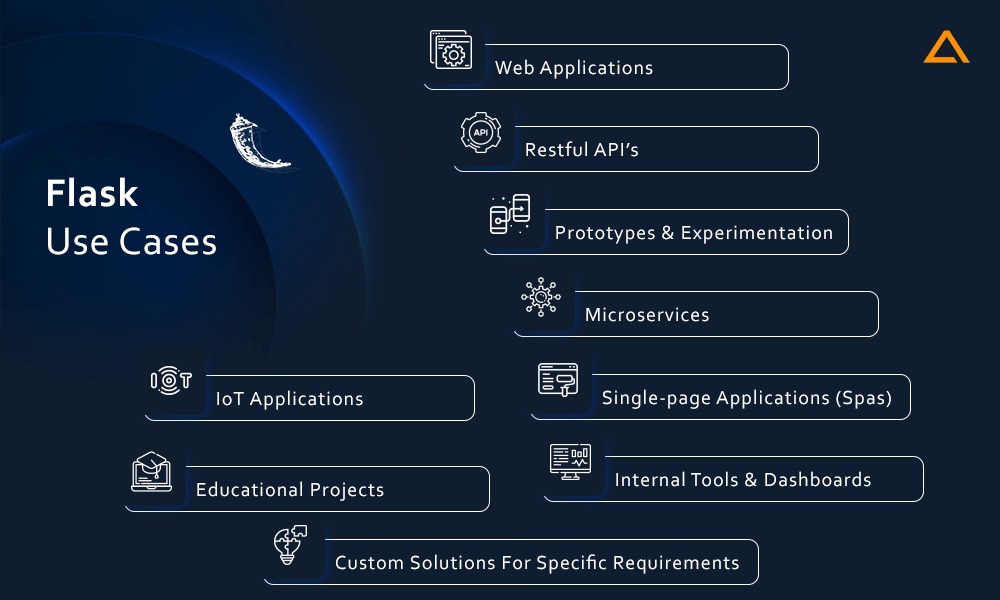
Pros and Cons
| Pros | Cons |
| Lightweight and minimalistic framework | Lack of built-in features compared to comprehensive frameworks |
| Flexible & Customization | Less suitable for large-scale applications with complex requirements |
| Extensive ecosystem of extensions & plugins | Requires additional configuration & integration of libraries for certain functionalities |
| Well-documented with a large & active community | More manual configuration compared to other frameworks |
| Python Integration | This may require implementing certain features from scratch or relying on third-party libraries. |
Also Read: – Ruby vs Python
aiohttp
Stars: 13.5K |Forks: 1.9K |Contributors: 610
Type: Framework
Mainly used for: Developing web applications and APIs
Install: pip install aiohttp==3.8.3
License: Apache-2.0
aiohttp is a Python library mainly used for building asynchronous HTTP-based client and server applications. It leverages Python’s asyncio library for the efficient handling of concurrent requests, making it ideal for developing high-performance and scalable web applications, APIs, and web scraping tools. aiohttp supports various HTTP features like Web Sockets, cookies, sessions, and SSL/TLS encryption. It provides an easy-to-use API for making HTTP requests and handling responses asynchronously, enabling developers to build efficient and responsive applications that can handle many concurrent connections.
Key Features
- aiohttp is designed for handling asynchronous HTTP requests, allowing for efficient concurrency & responsiveness
- Using aiohttp allows developers to build a complete web application as it provides both client & server-side functionalities
- aiohttp allows real-time bidirectional communication between servers & clients using built-in WebSocket communication support
- aiohttp supports various HTTP features such as cookies, sessions, SSL/TLS encryption, content compression, and authentication
- It allows the use of middleware components to customize & extend the functionality of the application
- It also provides flexibility in deployment options as it can help in integrating with different asyncio, Gunicorn, and uWSGI
- aiohttp allows efficient content streaming, which enables the processing of large files or streaming responses to clients
- aiohttp provides a routing system for mapping URLs to specific handlers, making it easy to define and handle different routes in an application
- aiohttp provides tools and methods for testing applications, making it easier to write test cases for various functionalities
Use Cases
- Asynchronous Web Applications
- RESTful API
- Web Scraping
- Real-Time Applications
- Microservices
- Proxy servers
- Load Testing
- Streaming Applications
- IoT Applications

Pros and Cons
| Pros | Cons |
| Asynchronous | Can be more complex to understand |
| Flexibility | Learning Curve |
| Built-in Web Socket support | Limited ecosystem |
| Supports various HTTP features | Limited compatibility |
| Efficient Content Streaming | May not be suitable for all projects |
| Easier application testing | – |
Pre-commit
Stars: 10.4K |Forks: 722K |Contributors: 122
Type: Framework
Mainly used for: managing and maintaining multi-language pre-commit hooks.
Install: pip install pre-commit==3.0.2
License: MIT
Last but not the least in our list of python frameworks is pre-commit. Pre-commit is a Popular Python framework and command-line tool used to maintain code quality by running configurable checks and fixes before committing changes. It integrates with the version control systems like Git, executing pre-commit hooks on each commit. With pre-configured and custom hooks, it enforces code formatting and style guidelines. Enforcing quality standards, ensures clean and compliant code, improving overall codebase quality and reducing potential issues.
Key Features
- Pre-commit allows developers to configure a set of hooks, specifying the tools and checks to be run before committing code
- It seamlessly integrates with popular version control systems like Git automatically triggering pre-commit hooks on each commit
- Pre-commit provides a wide range of pre-configured hooks for common tasks such as code formatting, linting, and more
- Developers can define their custom hooks to run specific checks or perform additional tasks based on project requirements
- Certain hooks in pre-commit can automatically fix issues, saving time by applying fixes before committing changes
- pre-commit optimizes performance by running only the necessary hooks on modified files, reducing unnecessary checks on unchanged code
- It can be seamlessly integrated into existing development workflows, allowing for smooth adoption and integration with CI/CD pipelines
- pre-commit works across different operating systems, making it suitable for projects with diverse development environments
- It provides an easy-to-use configuration file format, allowing developers to define hooks and their configurations clearly and concisely
Use Cases
- Enforcing Code Style
- Code Linting
- Security Checks
- Automated Testing
- Commit Message
- Dependency Management
- Continuous Integration
- Documentation Validation

Pros and Cons
| Pros | Cons |
| Enforce code quality | Requires initial setup & configuration |
| Catches potential issues early | Add an extra step before committing code |
| Improves code consistency | May introduce a small overhead in commit time |
| Supports a wide range of hooks | Requires developers to adhere to configured checks |
| Automates code formatting and linting | May require occasional Maintenance for hook updates |
| Allows custom hooks and configuration | Can generate false positives or false negatives in checks |
| Integrates with popular version control systems | Can require a learning curve for setting up hooks |
| Helps maintain clean commit history | Dependencies on external tools for some hooks |
| Facilitates integration of CI/CD pipelines | Relies on developer’s disciplines to fix detected issues |
Requests
Stars: 49.5K |Forks: 9.1K |Contributors: 620
Type: Library
Mainly used for: making HTTP requests
Install: python -m pip install requests
License: Apache-2.0 license
The Requests library is a popular Python library used for making HTTP requests. It provides a simplified and intuitive API for sending HTTP requests and handling responses. With Requests, developers can easily perform common HTTP operations such as GET, POST, PUT, DELETE, and more. The library supports various authentication methods, cookies, sessions, and SSL/TLS encryption. It also offers convenient features like automatic content decoding, JSON parsing, and file uploads. Requests are widely used for web scraping, interacting with RESTful APIs, testing web services, and building web applications that rely on making HTTP requests.
Key Features
- The requests library offers a user-friendly and intuitive API for simplifying the process of sending HTTP requests & handling responses
- It supports common HTTP verbs such as GET, POST, PUT, DELETE, and OPTIONS making it easy to interact with web services
- Requests support various authentication methods like Basic, Digest, and OAuth, ensuring secure communication with authenticated APIs
- The library provides support for sessions and cookies, allowing for efficient and stateful interactions with web applications
- Requests seamlessly handle SSL/TLS encryption, ensuring secure communication with servers that require it
- It provides convenient methods to access response headers, content, and status codes, simplifying the extraction of relevant information
- Requests automatically decode content based on response headers, making it easy to handle compressed or encoded responses
- The library includes built-in JSON parsing, simplifying the handling of JSON data returned from APIs
- Requests support file uploads as part of HTTP requests, making it useful for transferring files or making multipart/form-data requests
- Developers can easily set custom headers and query parameters in requests, allowing for flexibility in specifying request details
- Requests provide support for making HTTP requests through proxies, enabling communication with services behind firewalls or within restricted networks
Use Cases
- Web Scrapping
- API Integration
- Authentication & Authorization
- Data Collection & Aggregation
- Testing Web Service
- Proxy request
- HTTP Request manipulation
- Performance Testing

Pros and Cons
| Pros | Cons |
| Simplifies API for making HTTP requests | Limited support for asynchronous request |
| Supports common HTTP authentication methods | Not designed for heavy concurrency |
| Efficient handling of sessions & cookies | Requires manual handling of requests timeouts and retries |
| Built-in support for SSL/TLS encryption and secure communication | No built-in support for WebSocket communication |
| Convenient methods for accessing response headers, content, and status code | Relies on external libraries for advanced functionalities like connection pooling |
| Automatic content decoding & JSON parsing | Not designed for handling large file uploads efficiently |
| Flexible customization options for headers, query, parameters, and request details | Limited built-in support for request caching |
| Proxy support for making requests through intermediaries | Limited support for handling streaming response |
| Easy Integrations with popular Python libraries and frameworks | May require additional dependencies |
| Well-documented and robust community | May not provide built-in support for some niche or specialized protocols |
Are you looking to hire Python developer?
Hire a dedicated team from Aglowid for high-quality python developers who are equipped with the latest Python skill-sets
NumPy
Stars: 23.5K |Forks: 8.1K |Contributors: 1479
Type: Library
Mainly used for: Scientific Computing
Install: pip install numpy==1.24.1
License: BSD-3-Clause
NumPy is a Python library used for numeric computing. It provides efficient multidimensional array objects and functions for mathematical operations. With its powerful array manipulation capabilities, NumPy is widely employed in data analysis, scientific research, and machine learning. It serves as the footing for developing various other scientific and data-oriented Python libraries. NumPy has become essential for performing advanced numerical computations in Python with the functionalities like array indexing, slicing, and linear algebra operations.
Key Features
- NumPy provides efficient multidimensional array objects for numerical computing
- It offers a wide range of mathematical functions and operators for element-wise operations on arrays
- NumPy supports broadcasting, enabling operations between arrays of different shapes
- It provides flexible indexing and slicing capabilities for accessing and manipulating array elements
- NumPy includes comprehensive linear algebra functions for matrix operations and solving equations
- It seamlessly integrates with other scientific Python libraries for data analysis and computation
- NumPy’s array operations are implemented in optimized C code, ensuring fast and efficient computation
Use Cases
- Data Analysis and Manipulation
- Scientific Computing
- Machine Learning
- Financial Modelling
- Computational Physics
- Data Visualization
- Robotics & Bioinformatics
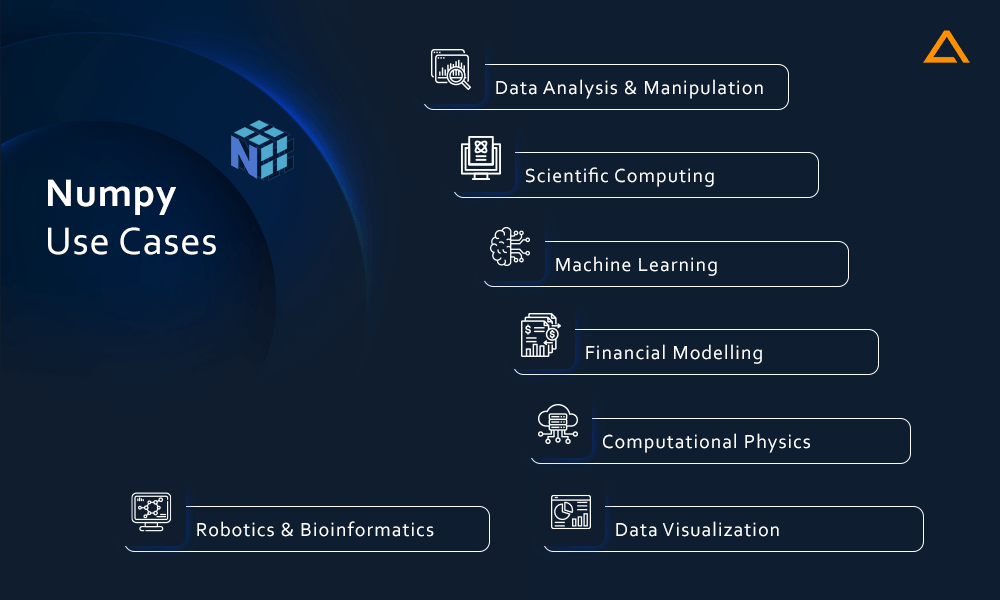
Pros and Cons
| Pros | Cons |
| High Performance | Steep Learning Curve |
| Broad Functionalities | Lack of Flexibility |
| Integration with Ecosystem | Global Interpreter Lock |
| Memory Efficiency | Limited GPU Support |
| Extensibility | Complex API |
Pandas
Stars: 38.4K |Forks: 16.3K |Contributors: 2926
Type: Library
Mainly used for: Analyzing data
Install: pip install pandas
License: BSD-3-Clause
Pandas is a Python library used for data manipulation and analysis. It offers high-performance data structures like Data Frames and Series, along with functions for data visualization and transformation. It provides powerful data indexing and slicing, handles missing data efficiently, and seamlessly integrates with other Python libraries like NumPy and Matplotlib, making it a valuable tool for data-centric workflows.
Key Features
- Data Frames for efficient manipulation and analysis of structured data
- Data cleaning and handling of missing data
- Data transformation operations like filtering, sorting, grouping, and reshaping
- Flexible indexing and slicing for extracting subsets of data
- Time series analysis with date/time indexing and operations
- Integration with other libraries like NumPy and Matplotlib
- Data visualization capabilities
- Input/output support for various file formats
- Flexible data structures beyond Data frames, such as Series, Panel, and MultiIndex
Use Cases
- Data Cleaning & Pre-processing
- Exploratory Data Analysis
- Data wrangling & transformation
- Time series analysis
- Financial Analysis
- Machine Learning and Data Modelling
- Business Intelligence & Reporting
- Data Visualization
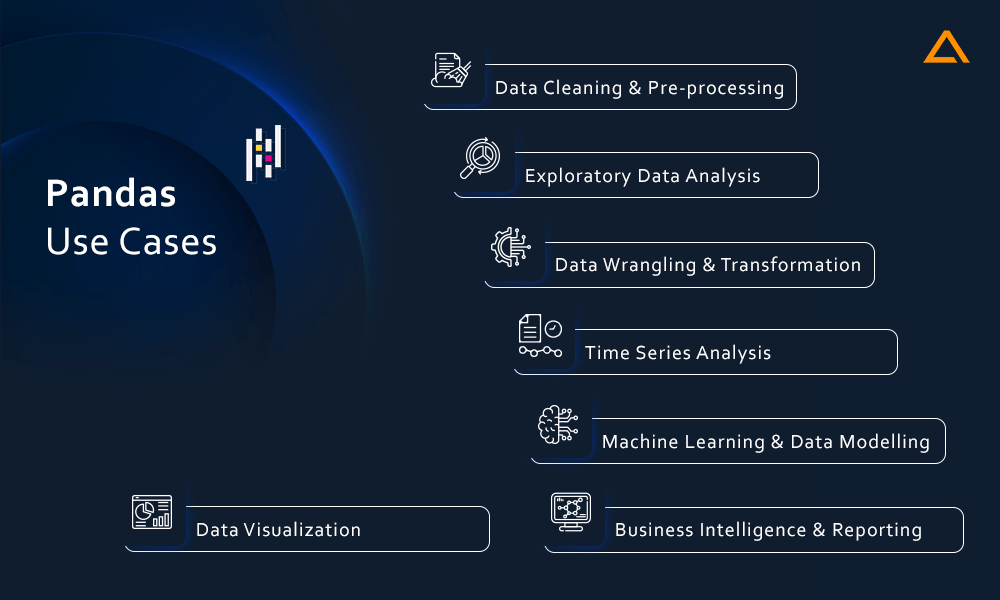
Pros and Cons
| Pros | Cons |
| Powerful & Efficient | Steep learning curve |
| Data Cleaning & transformation | Memory Usage |
| Data Integration & Interpretability | Performance Limitations |
| Data Exploration & Analysis | Limited Support for Big Data |
| Widely Adopted & Supported | API complexity |
Pillow
Stars: 10.8K |Forks: 2K |Contributors: 378
Type: Library
Mainly used for: Python Imaging Library
Install: pip install Pillow==9.4.0
License: HPND
The Pillow is a popular Python library for image processing and manipulation. It provides a wide range of functions and methods for opening, editing, enhancing, and saving images in various formats. The pillow supports basic image operations like cropping, resizing, rotating, and flipping. It also offers advanced image processing capabilities such as filtering, blending, and color adjustments. With Pillow, you can handle image metadata, apply text and graphic overlays, and perform image format conversions.
Key Features
- The pillow provides functions for image manipulation, including resizing, cropping, rotating, flipping, and adjusting image attributes
- It offers tools for image enhancement, such as brightness, contrast, sharpness adjustments, and color correction
- The pillow supports image filtering operations like blurring, sharpening, edge detection, and noise reduction
- It can read, save, and convert images in various formats such as JPEG, PNG, GIF, BMP, TIFF, and more
- The pillow allows access and modification of image metadata, including EXIF data
- You can add text and graphic overlays like watermarks or annotations to images using Pillow
- Pillow facilitates conversion between different image formats
Use Cases
- Image Processing and Editing
- Web Development
- Machine Learning
- Digital Media & Content Creation
- Data Visualization
- Scientific Research & Analysis
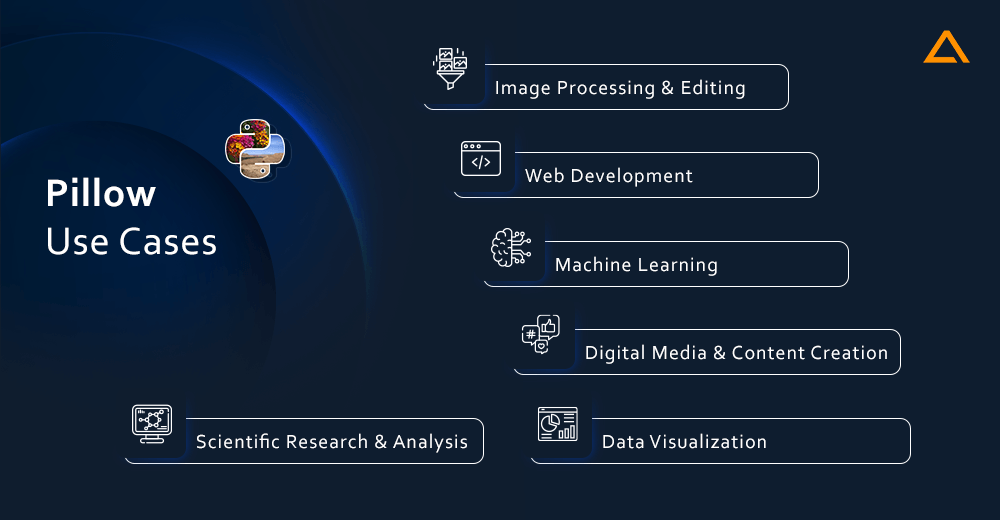
Pros and Cons
| Pros | Cons |
| Comprehensive Functionalities | Lack of detailed documentation |
| Supports a wide range of image formats | Limited support for advanced image processing techniques |
| Easy to use & install | Slower compared to specialized libraries |
| Active community support | High Memory consumption |
| Cross-platform compatibility | Not as performant as lower-level image-processing libraries |
| Wide range of image manipulation operations | Limited support for deep-learning image processing |
| Extensible with plugins | Limited GPU support |
TensorFlow
Stars: 175K |Forks: 88.3K |Contributors: 3375
Type: Library
Mainly used for: machine learning & deep neural networks research
Install: pip install tensorflow
License: Apache-2.0 license
An open-source machine learning framework termed TensorFlow was created by Google. It features strong support for deep learning and machine learning, as well as a modular numerical computation core that is applied across many different scientific fields. Using several platforms, including but not limited to CPUs, GPUs, and TPUs, is made simple by the flexible design. Multiple layers in the deep learning models allow for the learning of complicated patterns and data representation.
Key Features
- TensorFlow utilizes graph-based computation to represent & execute complex mathematical operations
- For efficient gradient computing during neural network training, TensorFlow provides automatic differentiation
- It offers flexibility to develop and train scalable modules across various platforms including CPUs, GPUs, and distributed systems
- TensorFlow has a rich ecosystem, with trained models and access to popular datasets for diverse machine learning and deep learning tasks
- TFX (TensorFlow Extended) provides end-to-end support for machine learning libraries and tools developed on TensorFlow
- TensorFlow includes Tensor Board, a web-based visualization tool for analyzing and monitoring the training process
Use cases
- Image Classification & Object Detection
- Natural Language Processing (NLP)
- Anomaly Detection
- Speech Recognition & Synthesis
- Recommendation System
- Time Series Forecasting
- Generative Models
- Reinforcement Learning
- Robotics & Control System
- Healthcare & Medical Imaging
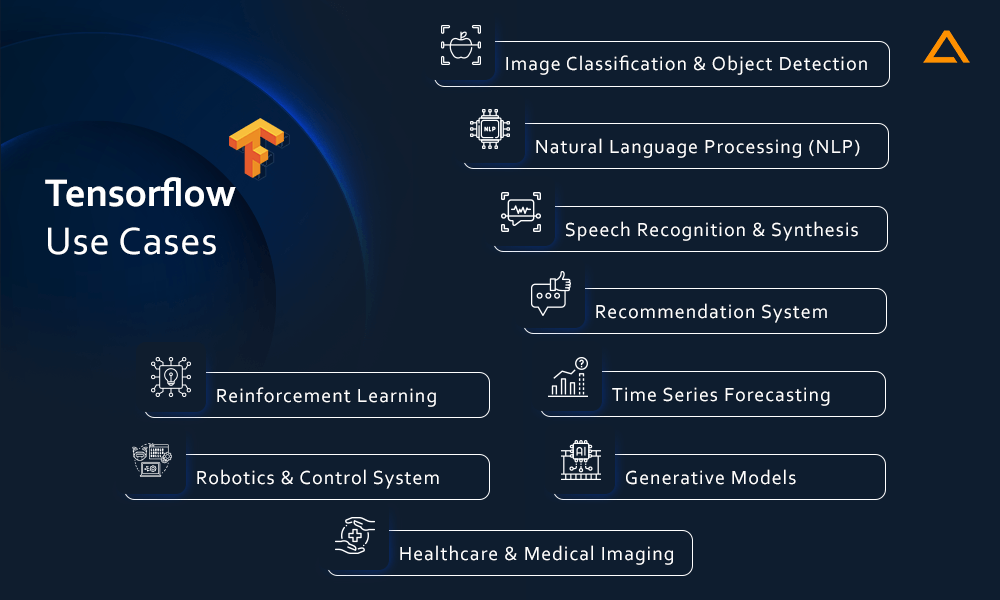
Pros and Cons
| Pros | Cons |
| Versatile Framework | Steep Learning Curve |
| Scalability for distributed computing | Verbose Syntax |
| Rich Ecosystem & Community Support | Documentation issues |
| Tensor Board for Visualizing & Monitoring | Performance Overhead |
| Deployment Flexibility | Limited Mobile Support |
| Production-ready tools | – |
Scikit-Learn
Stars: 54.3K |Forks: 24.3K |Contributors: 2660
Type: Library
Mainly used for: machine learning
Install: pip install -U scikit-learn
License: BSD-3-Clause license
Scikit-learn also known as sklearn is an open-source machine-learning library for Python. It provides a comprehensive set of tools for various machine learning tasks, as it is built on NumPy, SciPy, and Matplotlib. It is designed to be user-friendly, efficient, and accessible to both beginners & experienced machine learning practitioners.
Key Features
- It offers a wide range of algorithms for classification, regression, clustering, and dimensionality reduction
- Provides tools for data pre-processing & feature engineering
- Functions and metrics for model evaluation and selection
- Seamless integration with data pipelines
- Interoperability with other Python libraries like NumPy, Pandas, and Matplotlib
- Extensibility and customizability for implementing and integrating custom machine learning algorithms
Use Cases
- Classification
- Regression
- Clustering
- Dimensionality Reduction
- Model Selection
- Pre-processing
- NLP
- Time series analysis
- Ensemble Method
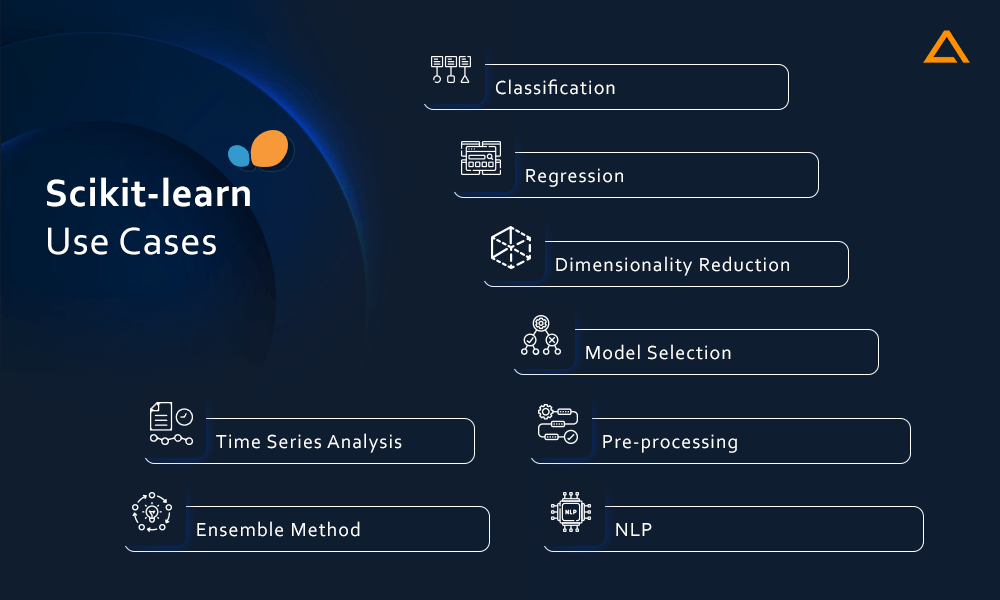
Pros and Cons
| Pros | Cons |
| Wide range of machine learning algorithms | Limited deep learning support |
| Comprehensive documentation | Constrained scalability for large datasets |
| Easy to Learn & User-friendly | Lack of support for distributed computing |
| Seamless Integrations | May not provide the required performance in some domain |
| Robust model evaluation & selection tool | Limited customization option for algorithm |
| Active community support | Relatively slower execution speed |
Also Read: – Python Best Practices to Follow in 2024
PyTorch
Stars: 66.9K |Forks: 18.3K |Contributors: 2660
Type: Library
Mainly used for: Machine Learning
Install: pip install -U scikit-learn
License: BSD-3-Clause license
An adaptable and effective framework for creating and training neural networks is provided by PyTorch, an open-source deep-learning toolkit for Python. It offers smooth model building and optimization using a dynamic computing graph and GPU acceleration. Backpropagation is made easier by its automatic differentiation feature, which also seamlessly connects with the Python ecosystem. PyTorch is a popular research tool that offers resources for model deployment in real-world settings.
Key Features
- PyTorch’s dynamic computation graph allows for flexible model architecture changes and easy debugging
- With efficient GPU acceleration, PyTorch enables faster tensor computations for improved training and inference speed
- PyTorch’s automatic differentiation simplifies back propagation by calculating gradients automatically
- The extensive collection of pre-built neural network modules in PyTorch facilitates model development with readily available components
- PyTorch’s Pythonic interface seamlessly integrates with the Python ecosystem, enabling easy data manipulation and integration with other libraries
- PyTorch’s flexibility and popularity in the research community make it a preferred choice for experimenting with novel model architectures and ideas
- PyTorch provides tools like Torch Script and ONNX for exporting and deploying models in production environments and on various platforms
Use Cases
- Image Classification
- Time Series Analysis
- Research & Prototyping
- Transfer Learning
- Generative Models
- Natural Language Processing
- Object Detection & Segmentation
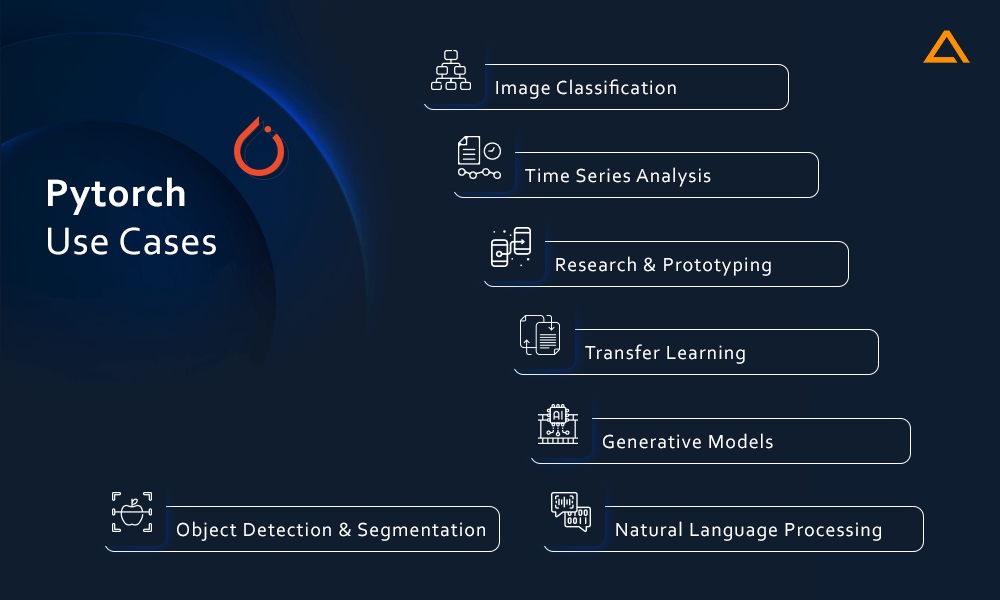
Pros and Cons
| Pros | Cons |
| Dynamic Computation Graph | Steep Learning Curve |
| Efficient GPU acceleration | Less Mature Ecosystem |
| Automatic differentiation | Requires more low-level coding |
| Extensive neural network modules | Limited built-in support |
| Pythonic interface | Relatively slower execution |
| Research-focused framework | Less trained models available |
| Model deployment tools | Smaller Community |
OpenCV (Open-Source Computer Vision)
Stars: 68.8K |Forks: 55.3K |Contributors: 1477
Type: Library
Mainly used for: Computer Vision Algorithms
Install: conda install -c conda-forge opencv
License: Apache-2.0
OpenCV is a widely used open-source library for computer vision and image processing tasks. It offers a comprehensive set of functions and algorithms that enable tasks such as image and video manipulation, object detection and tracking, facial recognition, and real-time computer vision applications. OpenCV supports various programming languages, including Python and C++, making it accessible and versatile for a range of computer vision projects.
Key Features
- OpenCV provides a wide range of functions and algorithms for image and video processing, enabling tasks like resizing, filtering, and frame extraction
- With pre-trained models and algorithms, OpenCV facilitates object detection, tracking, and recognition in images and videos
- OpenCV includes tools for feature extraction and matching, essential for tasks such as image-stitching and 3D reconstruction
- OpenCV offers functions for camera calibration, allowing for accurate geometric measurements and image rectification
- OpenCV seamlessly integrates with machine learning frameworks like TensorFlow and PyTorch, enabling the development of end-to-end computer vision pipelines
- Optimized for real-time applications, OpenCV provides functions and techniques for real-time object detection, tracking, and augmented reality
- OpenCV is cross-platform and supports multiple programming languages like Python, C++, and Java, making it accessible for developers on various platforms
- Supported by a large and active community, OpenCV provides extensive documentation, tutorials, and code samples for easy adoption and learning
Use Cases
- Object Detection & Tracking
- Facial Recognition & Biometrics
- Augmented Reality (A/R)
- Video & Image Recognition
- Object Detection & Tracking
- Robotics & Machine Vision
- Medical Imaging
- Gesture Recognition

Pros and Cons
| Pros | Cons |
| Wide Range of Function | Steep Learning Curve |
| Extensive Algorithm Collection | Lack of Deep Learning Support |
| Real-Time Capabilities | Limited High-Level Abstractions |
| Cross-platform Compatibility | Relatively Low-Level Programming |
| Large & Active Community | Limited Documentation |
| Multiple Language Bindings | Suboptimal Performance |
| Integration with Machine Learning | Lack of built-in GUI Support |
| Open-Source & Free | Limited Support for 3D Computer Vision |
Things to consider while choosing from the list of Python libraries
It can be a headache to select the best match of Python library for your project when there are ‘n’ number of libraries available at your disposal. However, there are a few things that you need to keep in mind while selecting the top Python libraries which can help you in making an informed decision. Have a look at them below.
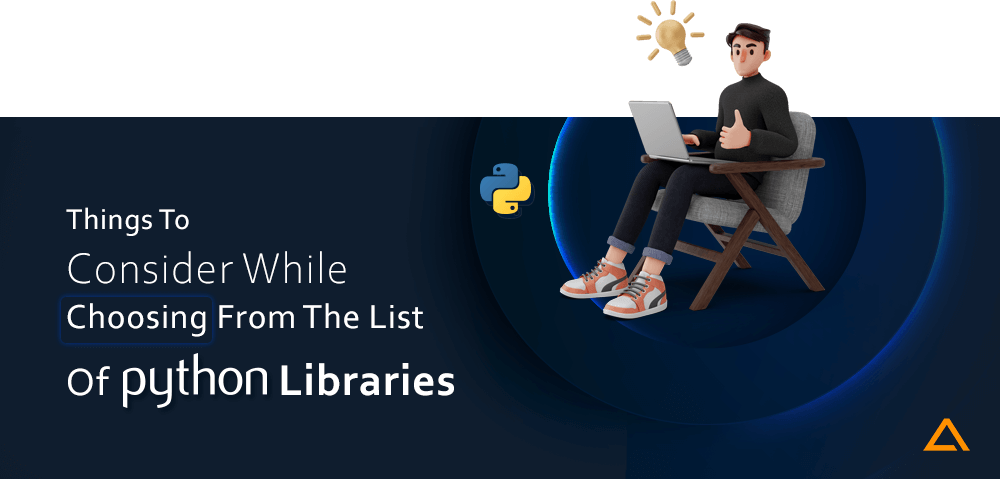
Purpose
One of the most fundamental checks you should perform is that the library you’re choosing meets your needs. It’s crucial to consider whether your project and the library’s primary functionality align. What features will it have? Or what problems you must resolve to make sure the library you pick complies with those demands.
Documentation
Proper documentation is must-have for a library. Check if the library has comprehensive and up-to-date documentation. The documentation should clearly explain the features, functionalities, and usage examples. Clear documentation can save a significant amount of time and effort spent on understanding the functionalities of the library.
Community Support
Consider the size and activity of the library’s community. A strong and active community can provide valuable support, answer your questions, and contribute to the library’s development. Look for active forums, mailing lists, GitHub repositories, or other online communities associated with the library to get a better idea about the library’s activity.
Maintenance and Updates
Check the library’s maintenance history and the frequency of updates. An actively maintained library with regular updates is more likely to have bug fixes, new features, and better compatibility with the latest versions of Python and other related libraries.
Popularity and Adoption
Check the library’s Maintenance history and update frequency. Popular libraries usually have a larger user base and are more reliable, well-tested, and actively maintained. They also have more community resources and 3rd party integrations available.
Compatibility
Another important thing that you need to take into consideration is compatibility. Ensure that the library is compatible with the version of Python you are using. Some libraries may only support specific Python versions or have limitations with certain platforms or operating systems. Check the library’s documentation or website for compatibility information.
Performance
Consider the library’s performance characteristics. Depending on your use case, you may need a library that is optimized for speed, memory usage, or scalability. Look for benchmarks or performance comparisons if available.
Licensing
Check the license under which the library is distributed. Ensure that the license aligns with your project’s requirements and that you are comfortable with its terms. Common licenses for Python libraries include MIT, Apache, GPL, and BSD licenses.
Dependencies
Examine the library’s dependencies and consider any potential conflicts with other libraries you are using. Libraries with minimal or well-managed dependencies are generally easier to integrate into your project.
Reviews and Recommendations
Read reviews and recommendations from other developers or experts who have used the library. Their experiences and insights can provide valuable information about the library’s strengths, weaknesses, and suitability for your specific use case.
Conclusion
In conclusion, Python’s diverse range of Python frameworks and libraries, including Django, Flask, NumPy, Pandas, and TensorFlow, offer developers a versatile and powerful toolkit for developing robust applications. With the support of frameworks and libraries, Python becomes an ideal language for web development, data science, and machine learning, providing productivity, efficiency, and community-driven support.
have a unique app Idea?
Hire Certified Developers To Build Robust Feature, Rich App And Websites.
Also Check:



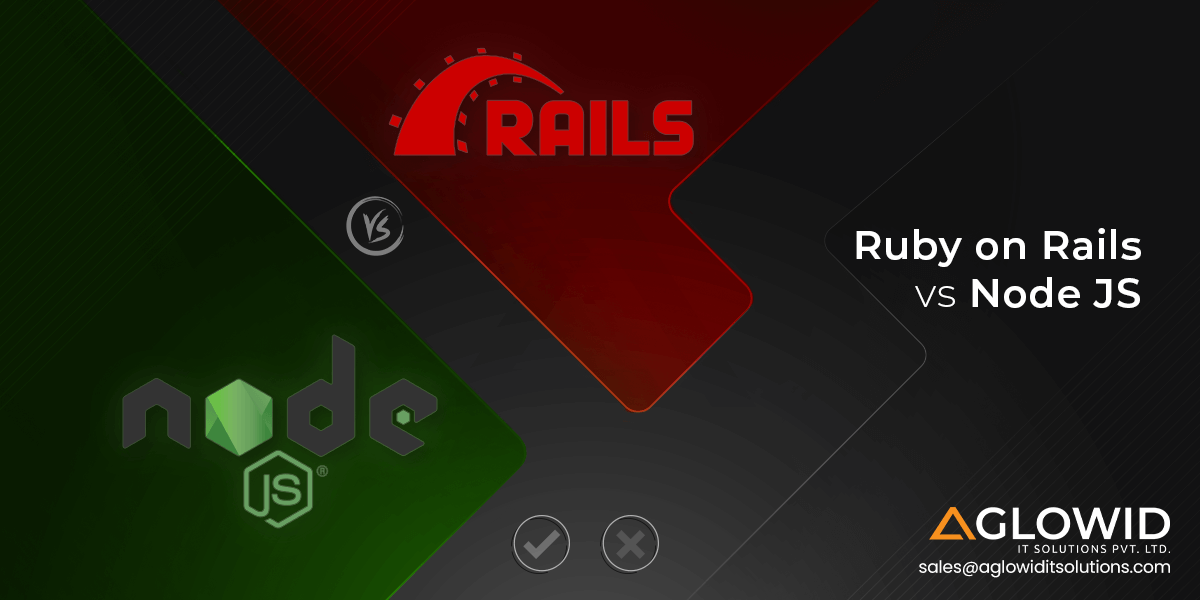
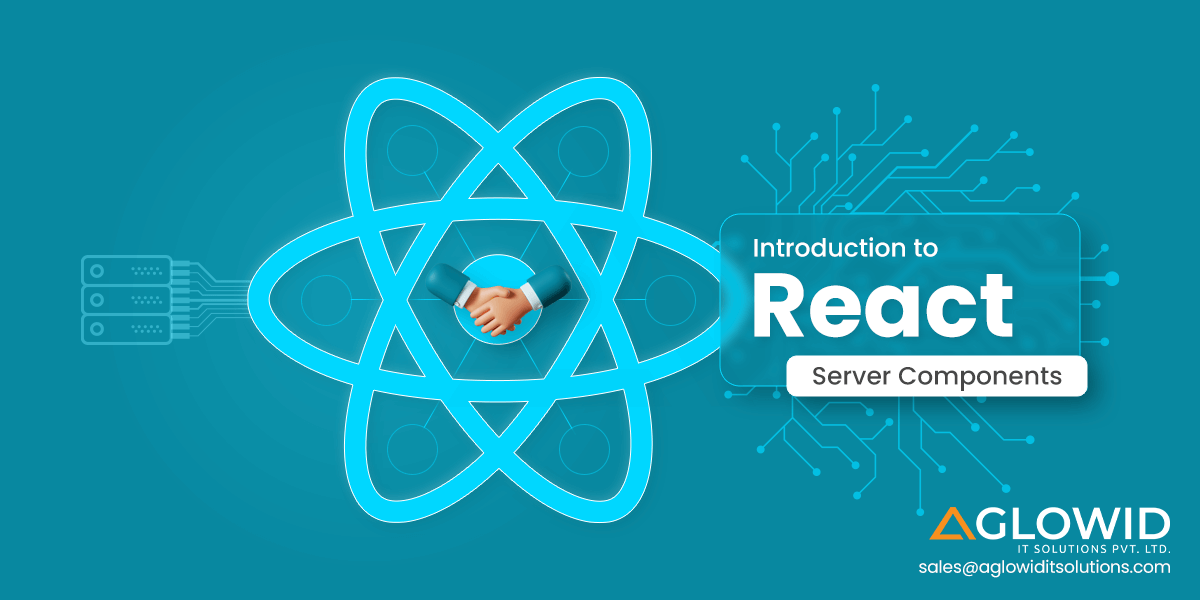


 Say
Say